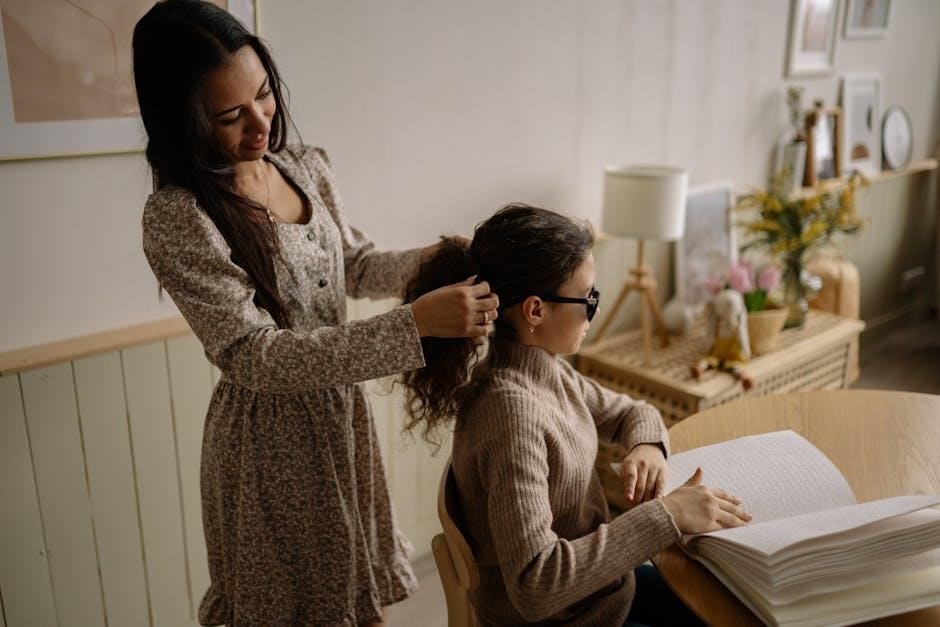“A Good Girl’s Guide to Murder” by Holly Jackson is a gripping YA mystery thriller that combines suspense, romance, and relatable teenage struggles, captivating readers worldwide with its twists.
1.1 Overview of the Book and Its Popularity
“A Good Girl’s Guide to Murder” has garnered widespread acclaim for its gripping narrative and relatable protagonist, Pip Fitz-Amobi. The book, which won the British Book Awards’ Children’s Book of the Year 2020, has become a bestseller, resonating with readers of all ages. Its blend of mystery, romance, and teenage life creates a compelling story that keeps readers hooked. The novel’s fast-paced plot, filled with twists and turns, has been praised for its ability to balance suspense with heartfelt moments. Fans appreciate how the book tackles real-life issues while maintaining an engaging and thrilling tone. Its success has also led to a TV series adaptation, further cementing its popularity. The book’s appeal lies in its ability to captivate both young adult readers and adults, making it a standout in the YA mystery thriller genre.
1.2 The Author: Holly Jackson
Holly Jackson is the acclaimed author behind “A Good Girl’s Guide to Murder”, a book that has captivated readers with its sharp wit and intricate plotting. Known for her ability to craft relatable characters and gripping narratives, Jackson has established herself as a prominent voice in young adult literature. Her work often explores themes of mystery, romance, and teenage life, resonating deeply with her audience. Jackson’s writing style is praised for its fast-paced and engaging nature, making her books difficult to put down. With the success of “A Good Girl’s Guide to Murder” and its subsequent sequels, Jackson has solidified her place in the YA thriller genre, earning both critical acclaim and a dedicated fan base. Her ability to weave suspense with heartfelt moments has endeared her to readers of all ages.
1.3 The Genre: Young Adult Mystery Thriller
“A Good Girl’s Guide to Murder” falls squarely within the Young Adult Mystery Thriller genre, blending suspense, intrigue, and relatable teenage experiences. The book captivates readers with its fast-paced narrative, twists, and turns, keeping them hooked until the final reveal. While the story centers around a murder investigation, it also explores themes of romance, friendship, and the complexities of teenage life, making it appealing to a broad audience. The thriller aspect is heightened by the relatable protagonist, Pip, whose determination and wit drive the story forward. The genre’s mix of heart-pounding suspense and heartfelt moments ensures that readers are both entertained and emotionally invested. This blend of mystery, drama, and coming-of-age elements has made the book a standout in the YA thriller category, resonating with fans of crime fiction and character-driven stories alike.

Plot Summary and Key Themes
“A Good Girl’s Guide to Murder” follows Pip Fitz-Amobi as she investigates a murder, uncovering dark secrets and confronting personal struggles, all while exploring themes of justice, trauma, and teenage identity.
2.1 The Central Mystery: Uncovering the Truth
The central mystery revolves around Pip Fitz-Amobi’s investigation into the murder of Andie Bell, a high school student whose death was initially ruled a tragic suicide. Pip, determined to uncover the truth, delves into the case, revealing a web of secrets and lies that shook the small town. As she digs deeper, she encounters unexpected twists, including hidden relationships, false alibis, and shocking revelations about Andie’s life; The mystery keeps readers engaged with its fast-paced narrative and suspenseful plot, blending clues, interviews, and personal reflections. Pip’s relentless pursuit of justice not only uncovers the truth but also forces her to confront her own demons, making the mystery as much about self-discovery as it is about solving the crime. The book’s ability to balance intrigue with emotional depth captivates readers, keeping them hooked until the very end.
2.2 The Protagonist: Pip Fitz-Amobi
Pip Fitz-Amobi, the protagonist, is a sharp-witted and determined high school student who embarks on a journey to uncover the truth behind a tragic murder. Her curiosity and passion for true crime drive her investigation, making her relatable and endearing to readers. Pip’s character is well-rounded, showcasing her intelligence, resilience, and vulnerability as she navigates the complexities of teenage life and the darker aspects of her small town. Her dry humor and relatable struggles add depth to her personality, making her more than just a detective but a real girl dealing with real issues. Throughout the story, Pip’s growth is evident as she confronts her own fears and learns to balance her dual life as both a student and an amateur sleuth; Her character’s complexity and authenticity make her a standout figure in the young adult genre, resonating with readers of all ages.
2.3 Themes of Justice, Trauma, and Teenage Life
The novel delves into themes of justice, trauma, and the complexities of teenage life, resonating deeply with readers. Pip’s investigation not only uncovers the truth but also highlights the failings of the justice system and the lasting impact of unresolved crimes. Trauma is explored through Pip’s own struggles and the emotional scars of those affected by the murder, showing how past events shape present lives. The story also captures the essence of teenage existence, balancing the intensity of the mystery with relatable moments of friendship, school pressures, and self-discovery. Pip’s journey reflects the challenges of growing up, where the pursuit of truth and identity often intertwine. These themes are woven seamlessly into the narrative, making the book a compelling exploration of human emotion and societal issues.

Character Development and Relationships
Pip’s growth as a determined investigator highlights her resilience and wit, while her relationships with friends, family, and suspects add depth to the intricate mystery.
3.1 Pip’s Investigation and Growth
Pip Fitz-Amobi emerges as a determined and resourceful protagonist, driving the story with her relentless pursuit of truth. Her investigation into the murder case showcases her analytical mind and courage. Through her journey, Pip faces personal challenges, revealing her emotional depth and resilience. The story highlights her growth from a curious student to a determined sleuth, balancing her teenage life with the pressures of solving a complex mystery. Pip’s relationships with others evolve, offering insights into her character and motivations. Her experiences shape her perspective on justice, trauma, and the complexities of human behavior, making her a relatable and inspiring figure for readers. Pip’s transformation underscores her ability to navigate dark truths while maintaining her identity, leaving a lasting impression on the narrative.
3.2 Supporting Characters: Friends, Family, and Suspects
The supporting characters in “A Good Girl’s Guide to Murder” add depth and complexity to the story. Pip’s relationships with her friends, such as Ravi and Cara, highlight her loyalty and trust. Her family, particularly her parents, provide emotional support while dealing with their own struggles. The suspects in the murder case, including Sal and others, are skillfully portrayed, keeping readers guessing about their involvement. Each character’s distinct personality and motives contribute to the mystery. Their interactions with Pip reveal her resourcefulness and empathy, making the narrative engaging and relatable. The dynamic between Pip and these characters not only aids her investigation but also shapes her personal growth, showcasing how relationships can both challenge and strengthen her resolve. The well-crafted supporting cast enhances the story’s tension and emotional impact, leaving a lasting impression on readers.
3.3 The Role of Romance in the Story
Romance in “A Good Girl’s Guide to Murder” is subtly woven into the plot, adding a layer of complexity to Pip’s journey. While the mystery takes center stage, Pip’s relationships, particularly with Ravi Singh, provide emotional depth and balance to her intense investigation. Their bond evolves naturally, blending friendship, trust, and affection without overshadowing the thriller elements. The romantic subplot is not overly dramatic, instead reflecting the challenges and sweetness of teenage relationships. It serves as a reminder of Pip’s dual life as both a determined detective and a high school student. The romance enhances the story’s relatability, offering readers moments of warmth and normalcy amidst the suspense. This delicate integration of romance underscores Pip’s humanity and makes her character even more endearing to readers. The story skillfully avoids clichés, presenting a realistic portrayal of young love intertwined with mystery and personal growth.

The Book’s Reception and Reviews
“A Good Girl’s Guide to Murder” has received widespread acclaim for its fast-paced, gripping narrative and relatable protagonist, earning it a spot as a British Book Awards winner and a New York Times bestseller.
4.1 Critical Acclaim and Awards
“A Good Girl’s Guide to Murder” has garnered significant critical acclaim, earning the prestigious British Book Awards Children’s Book of the Year 2020 and being shortlisted for the Waterstones Children’s Book Prize. Critics praise its gripping narrative, twists, and relatable protagonist, Pip Fitz-Amobi. The book’s ability to blend mystery with teenage life resonated deeply, making it a New York Times bestseller. Reviewers highlight Holly Jackson’s masterful storytelling, which keeps readers hooked from start to finish. The novel’s fresh take on the YA thriller genre has solidified its place as a modern classic, with many hailing it as a must-read for fans of crime fiction. Its success has also led to a loyal fanbase and further recognition in the literary world.
4.2 Reader Feedback and Fandom
Readers worldwide have fallen in love with “A Good Girl’s Guide to Murder”, praising its fast-paced and engaging storyline. Many fans appreciate the relatable protagonist, Pip Fitz-Amobi, and her determined spirit. The book’s mix of mystery, romance, and humor has created a loyal fanbase, with readers often describing it as a “bingeable” read. The novel’s twists and turns have sparked countless discussions on social media and book clubs. Fans also commend the book’s ability to address serious themes like trauma and justice while maintaining an entertaining tone. The success of the book has led to the creation of fan art, fan fiction, and dedicated online communities. Its impact extends beyond the page, making it a cultural phenomenon among young adult readers. The fandom continues to grow, further solidifying the book’s place in popular culture.
4.3 Comparisons to Other YA Thrillers
“A Good Girl’s Guide to Murder” is often compared to other popular YA thrillers like Veronica Mars and Riverdale, blending mystery, suspense, and teenage drama seamlessly. Fans of Karen M. McManus’s One of Us Is Lying have also drawn parallels, appreciating the book’s sharp wit and relatable characters. Unlike some YA thrillers, Jackson’s novel stands out for its balance of humor and darkness, making it more approachable while still delivering intense twists. The modern, fast-paced narrative has also been likened to adaptations of Agatha Christie’s works, reimagined for a contemporary audience. By combining classic whodunit elements with fresh, teenage perspectives, “A Good Girl’s Guide to Murder” carves its own niche in the YA thriller genre, appealing to fans of both retro and modern mystery styles. Its unique voice sets it apart, offering a refreshing take on the genre.

The TV Series Adaptation
“A Good Girl’s Guide to Murder” was adapted into a successful six-part BBC series, now on Netflix, praised for its faithful take on the book’s gripping mystery and relatable themes.
5.1 The Adaptation Process and Changes
The TV series adaptation of “A Good Girl’s Guide to Murder” was developed by the BBC, maintaining the core mystery while introducing creative liberties. The six-part series, now available on Netflix, remains faithful to Holly Jackson’s original story but makes notable changes. Certain plotlines were simplified or omitted, particularly those involving secondary characters, to fit the condensed format. Additionally, some characters’ backstories were altered for dramatic effect. The series also expands on themes like Pip’s trauma and the community’s reaction to the murder, offering a fresh perspective. While the book delves deeper into Pip’s investigative process, the show emphasizes visual storytelling and character dynamics. These adjustments enhance the narrative for the screen without losing the essence of the source material;
5.2 The Cast and Their Performances
The cast of “A Good Girl’s Guide to Murder” delivers standout performances, bringing depth and nuance to the characters. Emma Myers shines as Pip Fitz-Amobi, capturing her determination and vulnerability. The chemistry between the leads is compelling, with actors portraying Sal Singh and Andie Bell adding emotional weight. Fans praise the casting for staying true to the book’s character descriptions while introducing fresh interpretations. The actors’ ability to balance the thriller’s intensity with relatable teenage dynamics has been widely acclaimed; Their performances enhance the story’s tension and emotional resonance, making the series a captivating watch for both book lovers and new audiences alike.
5.3 Viewer Response to the Series
Viewers have praised the series adaptation of “A Good Girl’s Guide to Murder” for its gripping storytelling and faithful adaptation of the book. Fans commend the show’s ability to maintain the original’s twists and suspense while introducing new elements. The series has been lauded for its fast-paced narrative, which keeps audiences hooked from start to finish. Many viewers appreciate how the show balances the mystery with relatable teenage dynamics, making it appealing to a broad audience. The cast’s performances, particularly Emma Myers as Pip, have been highlighted for bringing depth and authenticity to the characters. Overall, the series has been well-received, with viewers praising its blend of thriller, mystery, and romance, making it a standout adaptation in the YA genre.

Differences Between the Book and the Series
The series adaptation omits certain subplots and alters some character arcs compared to the book, offering a fresh perspective while maintaining the core mystery and suspense.
6.1 Plot Changes and Omissions
The TV series adaptation of “A Good Girl’s Guide to Murder” introduces notable plot changes and omissions compared to the book. Certain subplots, such as the detailed investigation into Andie’s death and Pip’s deeper emotional struggles, are simplified or omitted. The series also alters the portrayal of key characters, including Sal Singh, whose backstory and motives are less explored. Additionally, the show introduces new scenes and dialogues not present in the original novel, offering a fresh perspective while maintaining the core mystery. These changes aim to streamline the narrative for a visual medium, though some fans of the book feel that certain nuances were lost in the process. The adaptations reflect a balance between staying true to the source material and enhancing the story for a different format.
6.2 Character Portrayals: Book vs. Screen
The TV adaptation of “A Good Girl’s Guide to Murder” offers distinct character portrayals compared to the book. Pip Fitz-Amobi, the protagonist, is depicted with less emphasis on her internal monologue in the series, simplifying her complexity. In the book, Pip’s emotional depth and growth are central, while the show focuses more on her investigative determination. Ravi Singh, a key character, is given more screen time and backstory in the series, enhancing his role beyond the book’s portrayal. Conversely, certain characters, such as Naomi and Becca, are less fleshed out in the adaptation, reducing their impact on the narrative. These changes reflect the challenge of translating complex literary characters into a visual medium, where dialogue and action often take precedence over introspection.
6.3 Themes and Tone: Book vs. Series
The book and series differ in their exploration of themes and tone. The novel delves deeper into Pip’s internal struggles, emphasizing her trauma, guilt, and obsession with justice. It also explores darker themes like sexual assault, drugs, and the long-term effects of tragedy on a community. The series, while maintaining the mystery, tones down some of these elements, offering a more balanced tone that blends suspense with teenage drama and humor. The book’s tone is more introspective, reflecting Pip’s emotional turmoil through her journal entries, while the series relies on dialogue and visual storytelling. Both versions highlight the complexities of teenage life and the pursuit of truth, but the book provides a richer, more nuanced exploration of these themes.

The Impact of the Story
“A Good Girl’s Guide to Murder” has left a lasting impact on young adult literature, sparking conversations about justice, trauma, and teenage life while inspiring a devoted fan base globally.
7.1 Cultural and Social Relevance
“A Good Girl’s Guide to Murder” resonates deeply with its audience by addressing real-world issues such as teenage trauma, mental health, and the pressures of small-town life. Pip’s journey highlights the challenges of navigating societal expectations while seeking justice, making her a relatable and empowering protagonist. The book’s exploration of complex relationships and moral dilemmas encourages readers to reflect on their own experiences and biases. Additionally, the story’s portrayal of a strong, intelligent female lead challenges stereotypes and inspires young readers, particularly girls, to embrace their curiosity and resilience. The blend of mystery, romance, and humor appeals to a wide demographic, fostering a sense of connection and shared experience. Its cultural significance is further amplified by its adaptation into a TV series, bringing these themes to an even broader audience and sparking conversations about justice, identity, and growth.
7.2 The Influence on Young Adult Literature
“A Good Girl’s Guide to Murder” has left a significant mark on Young Adult (YA) literature, revitalizing the mystery-thriller genre and inspiring a new wave of stories centered around strong, intelligent female protagonists. Its success has paved the way for more YA novels that blend suspense, humor, and relatable teenage struggles. The book’s unique narrative style, combining investigative elements with personal growth, has influenced authors to experiment with similar storytelling techniques. Additionally, its exploration of complex themes like trauma, justice, and identity has raised the bar for YA fiction, encouraging deeper, more thought-provoking narratives. The novel’s popularity has also highlighted the demand for stories that cater to a diverse audience, blending genres seamlessly and appealing to readers of all ages. As a result, it has become a benchmark for modern YA thrillers, shaping the direction of the genre and inspiring future writers.
7.3 The Role of the Story in Popular Culture
“A Good Girl’s Guide to Murder” has become a cultural phenomenon, transcending literature to influence television and social media. Its adaptation into a Netflix and BBC series has introduced the story to a broader audience, further solidifying its place in popular culture. The book’s blend of mystery, romance, and humor has resonated with readers and viewers alike, making it a favorite among both teens and adults. Its cultural relevance stems from its modern themes, relatable protagonist, and the way it sparks conversations about justice, trauma, and identity. The story’s success has also inspired fan communities, merchandise, and discussions across online platforms, cementing its status as a defining work in contemporary young adult storytelling. Its impact continues to grow, making it a significant part of today’s pop culture landscape.
“A Good Girl’s Guide to Murder” is a captivating blend of mystery, romance, and teenage life, leaving a lasting impact on readers and viewers. Its success has solidified its place in popular culture, inspiring adaptations and fostering a devoted fan base. The story’s relatable protagonist, gripping plot, and modern themes ensure its influence will endure, making it a must-read and must-watch for fans of the genre.
8.1 The Legacy of “A Good Girl’s Guide to Murder”
“A Good Girl’s Guide to Murder” has cemented its place as a modern classic in young adult literature, leaving a lasting legacy. Its unique blend of mystery, romance, and relatable teenage struggles has resonated with readers globally. The book’s success led to a bestselling trilogy and a widely acclaimed TV adaptation, introducing the story to new audiences. By addressing themes like justice, trauma, and teenage life, it has become a cultural touchstone, sparking conversations and inspiring new works in the genre. The story’s impact extends beyond entertainment, offering a fresh perspective on complex issues. Its influence on popular culture and young adult literature ensures that “A Good Girl’s Guide to Murder” will remain a beloved and thought-provoking story for years to come.
8.2 Recommendations for Readers and Viewers
“A Good Girl’s Guide to Murder” is a must-read for fans of mystery and thriller genres, offering a compelling story with twists that keep readers hooked. Viewers who enjoy gripping narratives with strong female leads will also appreciate the TV adaptation. The book is particularly recommended for young adults and anyone who loves crime-solving stories with relatable characters. For those who prefer visual storytelling, the series provides an excellent adaptation that stays true to the book’s essence. Readers are encouraged to explore the entire trilogy to fully immerse themselves in Pip’s journey. Whether you choose the book or the series, this story promises an unforgettable experience filled with suspense, heart, and intrigue, making it a standout choice in the YA thriller category.
8.3 The Future of the Franchise
“A Good Girl’s Guide to Murder” has established itself as a cultural phenomenon, leaving a lasting impact on both literature and television. With the success of the book trilogy and the TV series adaptation, the franchise is poised for further growth. Fans eagerly anticipate potential sequels or spin-offs, exploring new mysteries or delving deeper into beloved characters. The adaptation’s strong reception suggests that the story could expand into additional seasons, potentially covering the remaining books in the series. Additionally, the franchise’s popularity opens doors for merchandise, movies, or even a cinematic universe. Creator Holly Jackson has hinted at exploring more stories within the same universe, exciting fans worldwide. As the franchise continues to captivate audiences, its future looks bright, ensuring that Pip’s legacy and the world of Little Kilton will remain a focal point in popular culture for years to come.
